Xinyuan Chen
LIA-X: Interpretable Latent Portrait Animator
Aug 13, 2025Abstract:We introduce LIA-X, a novel interpretable portrait animator designed to transfer facial dynamics from a driving video to a source portrait with fine-grained control. LIA-X is an autoencoder that models motion transfer as a linear navigation of motion codes in latent space. Crucially, it incorporates a novel Sparse Motion Dictionary that enables the model to disentangle facial dynamics into interpretable factors. Deviating from previous 'warp-render' approaches, the interpretability of the Sparse Motion Dictionary allows LIA-X to support a highly controllable 'edit-warp-render' strategy, enabling precise manipulation of fine-grained facial semantics in the source portrait. This helps to narrow initial differences with the driving video in terms of pose and expression. Moreover, we demonstrate the scalability of LIA-X by successfully training a large-scale model with approximately 1 billion parameters on extensive datasets. Experimental results show that our proposed method outperforms previous approaches in both self-reenactment and cross-reenactment tasks across several benchmarks. Additionally, the interpretable and controllable nature of LIA-X supports practical applications such as fine-grained, user-guided image and video editing, as well as 3D-aware portrait video manipulation.
Consistent and Controllable Image Animation with Motion Linear Diffusion Transformers
Aug 10, 2025Abstract:Image animation has seen significant progress, driven by the powerful generative capabilities of diffusion models. However, maintaining appearance consistency with static input images and mitigating abrupt motion transitions in generated animations remain persistent challenges. While text-to-video (T2V) generation has demonstrated impressive performance with diffusion transformer models, the image animation field still largely relies on U-Net-based diffusion models, which lag behind the latest T2V approaches. Moreover, the quadratic complexity of vanilla self-attention mechanisms in Transformers imposes heavy computational demands, making image animation particularly resource-intensive. To address these issues, we propose MiraMo, a framework designed to enhance efficiency, appearance consistency, and motion smoothness in image animation. Specifically, MiraMo introduces three key elements: (1) A foundational text-to-video architecture replacing vanilla self-attention with efficient linear attention to reduce computational overhead while preserving generation quality; (2) A novel motion residual learning paradigm that focuses on modeling motion dynamics rather than directly predicting frames, improving temporal consistency; and (3) A DCT-based noise refinement strategy during inference to suppress sudden motion artifacts, complemented by a dynamics control module to balance motion smoothness and expressiveness. Extensive experiments against state-of-the-art methods validate the superiority of MiraMo in generating consistent, smooth, and controllable animations with accelerated inference speed. Additionally, we demonstrate the versatility of MiraMo through applications in motion transfer and video editing tasks.
Self-Improvement for Audio Large Language Model using Unlabeled Speech
Jul 27, 2025Abstract:Recent audio LLMs have emerged rapidly, demonstrating strong generalization across various speech tasks. However, given the inherent complexity of speech signals, these models inevitably suffer from performance degradation in specific target domains. To address this, we focus on enhancing audio LLMs in target domains without any labeled data. We propose a self-improvement method called SI-SDA, leveraging the information embedded in large-model decoding to evaluate the quality of generated pseudo labels and then perform domain adaptation based on reinforcement learning optimization. Experimental results show that our method consistently and significantly improves audio LLM performance, outperforming existing baselines in WER and BLEU across multiple public datasets of automatic speech recognition (ASR), spoken question-answering (SQA), and speech-to-text translation (S2TT). Furthermore, our approach exhibits high data efficiency, underscoring its potential for real-world deployment.
GenHOI: Generalizing Text-driven 4D Human-Object Interaction Synthesis for Unseen Objects
Jun 18, 2025Abstract:While diffusion models and large-scale motion datasets have advanced text-driven human motion synthesis, extending these advances to 4D human-object interaction (HOI) remains challenging, mainly due to the limited availability of large-scale 4D HOI datasets. In our study, we introduce GenHOI, a novel two-stage framework aimed at achieving two key objectives: 1) generalization to unseen objects and 2) the synthesis of high-fidelity 4D HOI sequences. In the initial stage of our framework, we employ an Object-AnchorNet to reconstruct sparse 3D HOI keyframes for unseen objects, learning solely from 3D HOI datasets, thereby mitigating the dependence on large-scale 4D HOI datasets. Subsequently, we introduce a Contact-Aware Diffusion Model (ContactDM) in the second stage to seamlessly interpolate sparse 3D HOI keyframes into densely temporally coherent 4D HOI sequences. To enhance the quality of generated 4D HOI sequences, we propose a novel Contact-Aware Encoder within ContactDM to extract human-object contact patterns and a novel Contact-Aware HOI Attention to effectively integrate the contact signals into diffusion models. Experimental results show that we achieve state-of-the-art results on the publicly available OMOMO and 3D-FUTURE datasets, demonstrating strong generalization abilities to unseen objects, while enabling high-fidelity 4D HOI generation.
Faster than Fast: Accelerating Oriented FAST Feature Detection on Low-end Embedded GPUs
Jun 08, 2025Abstract:The visual-based SLAM (Simultaneous Localization and Mapping) is a technology widely used in applications such as robotic navigation and virtual reality, which primarily focuses on detecting feature points from visual images to construct an unknown environmental map and simultaneously determines its own location. It usually imposes stringent requirements on hardware power consumption, processing speed and accuracy. Currently, the ORB (Oriented FAST and Rotated BRIEF)-based SLAM systems have exhibited superior performance in terms of processing speed and robustness. However, they still fall short of meeting the demands for real-time processing on mobile platforms. This limitation is primarily due to the time-consuming Oriented FAST calculations accounting for approximately half of the entire SLAM system. This paper presents two methods to accelerate the Oriented FAST feature detection on low-end embedded GPUs. These methods optimize the most time-consuming steps in Oriented FAST feature detection: FAST feature point detection and Harris corner detection, which is achieved by implementing a binary-level encoding strategy to determine candidate points quickly and a separable Harris detection strategy with efficient low-level GPU hardware-specific instructions. Extensive experiments on a Jetson TX2 embedded GPU demonstrate an average speedup of over 7.3 times compared to widely used OpenCV with GPU support. This significant improvement highlights its effectiveness and potential for real-time applications in mobile and resource-constrained environments.
Training-free Stylized Text-to-Image Generation with Fast Inference
May 25, 2025Abstract:Although diffusion models exhibit impressive generative capabilities, existing methods for stylized image generation based on these models often require textual inversion or fine-tuning with style images, which is time-consuming and limits the practical applicability of large-scale diffusion models. To address these challenges, we propose a novel stylized image generation method leveraging a pre-trained large-scale diffusion model without requiring fine-tuning or any additional optimization, termed as OmniPainter. Specifically, we exploit the self-consistency property of latent consistency models to extract the representative style statistics from reference style images to guide the stylization process. Additionally, we then introduce the norm mixture of self-attention, which enables the model to query the most relevant style patterns from these statistics for the intermediate output content features. This mechanism also ensures that the stylized results align closely with the distribution of the reference style images. Our qualitative and quantitative experimental results demonstrate that the proposed method outperforms state-of-the-art approaches.
The Devil is in the Prompts: Retrieval-Augmented Prompt Optimization for Text-to-Video Generation
Apr 16, 2025Abstract:The evolution of Text-to-video (T2V) generative models, trained on large-scale datasets, has been marked by significant progress. However, the sensitivity of T2V generative models to input prompts highlights the critical role of prompt design in influencing generative outcomes. Prior research has predominantly relied on Large Language Models (LLMs) to align user-provided prompts with the distribution of training prompts, albeit without tailored guidance encompassing prompt vocabulary and sentence structure nuances. To this end, we introduce \textbf{RAPO}, a novel \textbf{R}etrieval-\textbf{A}ugmented \textbf{P}rompt \textbf{O}ptimization framework. In order to address potential inaccuracies and ambiguous details generated by LLM-generated prompts. RAPO refines the naive prompts through dual optimization branches, selecting the superior prompt for T2V generation. The first branch augments user prompts with diverse modifiers extracted from a learned relational graph, refining them to align with the format of training prompts via a fine-tuned LLM. Conversely, the second branch rewrites the naive prompt using a pre-trained LLM following a well-defined instruction set. Extensive experiments demonstrate that RAPO can effectively enhance both the static and dynamic dimensions of generated videos, demonstrating the significance of prompt optimization for user-provided prompts. Project website: \href{https://whynothaha.github.io/Prompt_optimizer/RAPO.html}{GitHub}.
AccVideo: Accelerating Video Diffusion Model with Synthetic Dataset
Mar 25, 2025
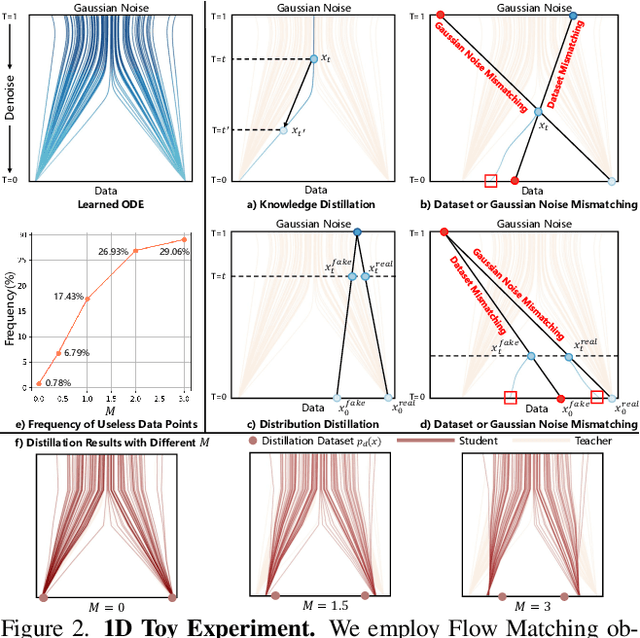

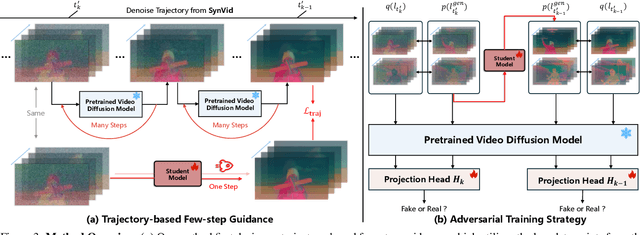
Abstract:Diffusion models have achieved remarkable progress in the field of video generation. However, their iterative denoising nature requires a large number of inference steps to generate a video, which is slow and computationally expensive. In this paper, we begin with a detailed analysis of the challenges present in existing diffusion distillation methods and propose a novel efficient method, namely AccVideo, to reduce the inference steps for accelerating video diffusion models with synthetic dataset. We leverage the pretrained video diffusion model to generate multiple valid denoising trajectories as our synthetic dataset, which eliminates the use of useless data points during distillation. Based on the synthetic dataset, we design a trajectory-based few-step guidance that utilizes key data points from the denoising trajectories to learn the noise-to-video mapping, enabling video generation in fewer steps. Furthermore, since the synthetic dataset captures the data distribution at each diffusion timestep, we introduce an adversarial training strategy to align the output distribution of the student model with that of our synthetic dataset, thereby enhancing the video quality. Extensive experiments demonstrate that our model achieves 8.5x improvements in generation speed compared to the teacher model while maintaining comparable performance. Compared to previous accelerating methods, our approach is capable of generating videos with higher quality and resolution, i.e., 5-seconds, 720x1280, 24fps.
GMG: A Video Prediction Method Based on Global Focus and Motion Guided
Mar 14, 2025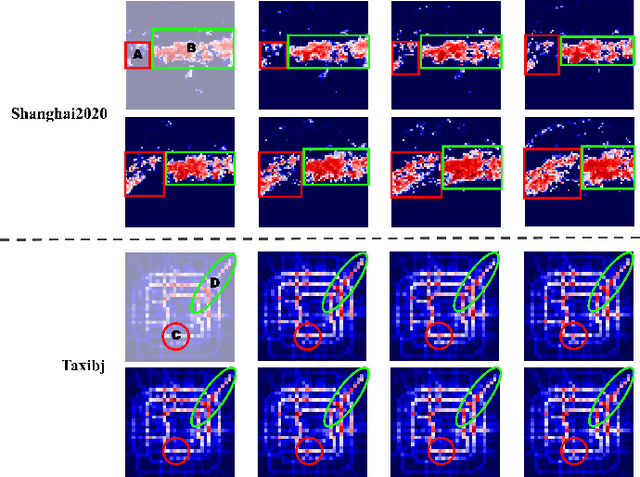
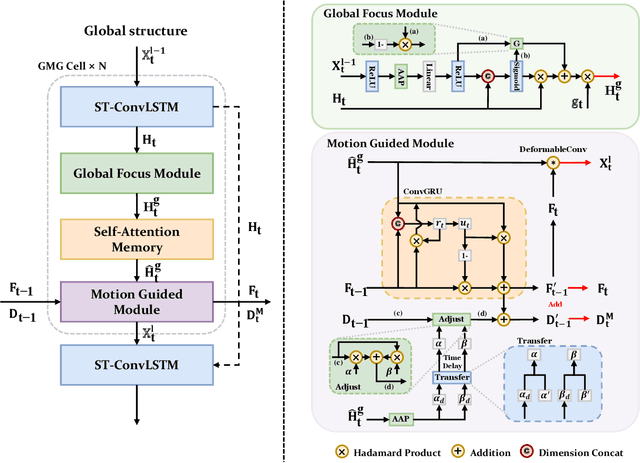
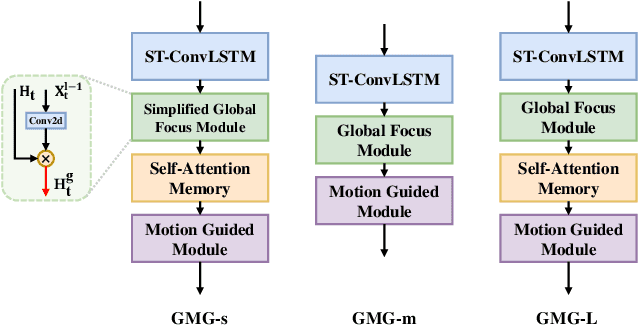
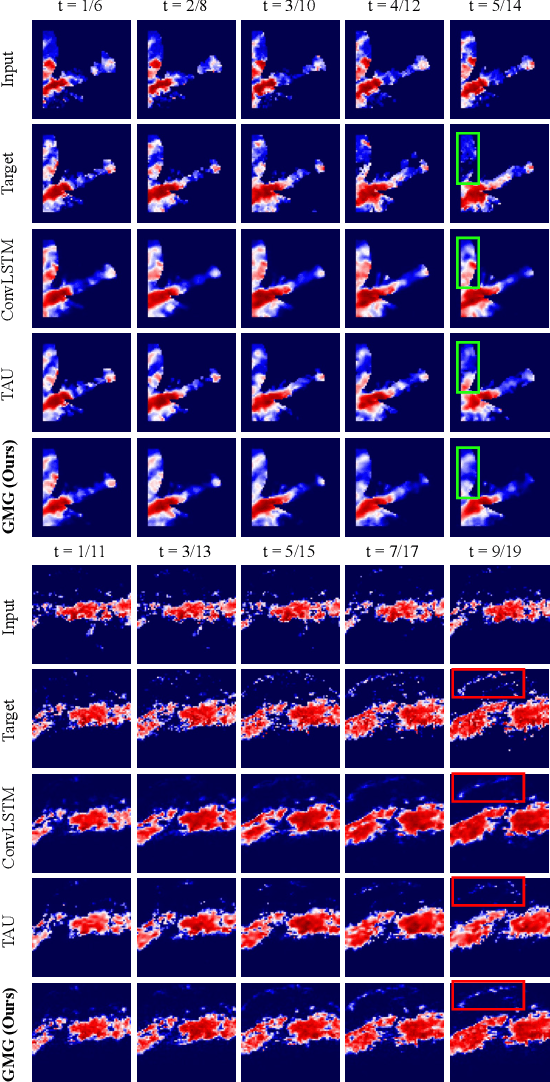
Abstract:Recent years, weather forecasting has gained significant attention. However, accurately predicting weather remains a challenge due to the rapid variability of meteorological data and potential teleconnections. Current spatiotemporal forecasting models primarily rely on convolution operations or sliding windows for feature extraction. These methods are limited by the size of the convolutional kernel or sliding window, making it difficult to capture and identify potential teleconnection features in meteorological data. Additionally, weather data often involve non-rigid bodies, whose motion processes are accompanied by unpredictable deformations, further complicating the forecasting task. In this paper, we propose the GMG model to address these two core challenges. The Global Focus Module, a key component of our model, enhances the global receptive field, while the Motion Guided Module adapts to the growth or dissipation processes of non-rigid bodies. Through extensive evaluations, our method demonstrates competitive performance across various complex tasks, providing a novel approach to improving the predictive accuracy of complex spatiotemporal data.
MouseGPT: A Large-scale Vision-Language Model for Mouse Behavior Analysis
Mar 13, 2025Abstract:Analyzing animal behavior is crucial in advancing neuroscience, yet quantifying and deciphering its intricate dynamics remains a significant challenge. Traditional machine vision approaches, despite their ability to detect spontaneous behaviors, fall short due to limited interpretability and reliance on manual labeling, which restricts the exploration of the full behavioral spectrum. Here, we introduce MouseGPT, a Vision-Language Model (VLM) that integrates visual cues with natural language to revolutionize mouse behavior analysis. Built upon our first-of-its-kind dataset - incorporating pose dynamics and open-vocabulary behavioral annotations across over 42 million frames of diverse psychiatric conditions - MouseGPT provides a novel, context-rich method for comprehensive behavior interpretation. Our holistic analysis framework enables detailed behavior profiling, clustering, and novel behavior discovery, offering deep insights without the need for labor - intensive manual annotation. Evaluations reveal that MouseGPT surpasses existing models in precision, adaptability, and descriptive richness, positioning it as a transformative tool for ethology and for unraveling complex behavioral dynamics in animal models.
 Add to Chrome
Add to Chrome Add to Firefox
Add to Firefox Add to Edge
Add to Edge